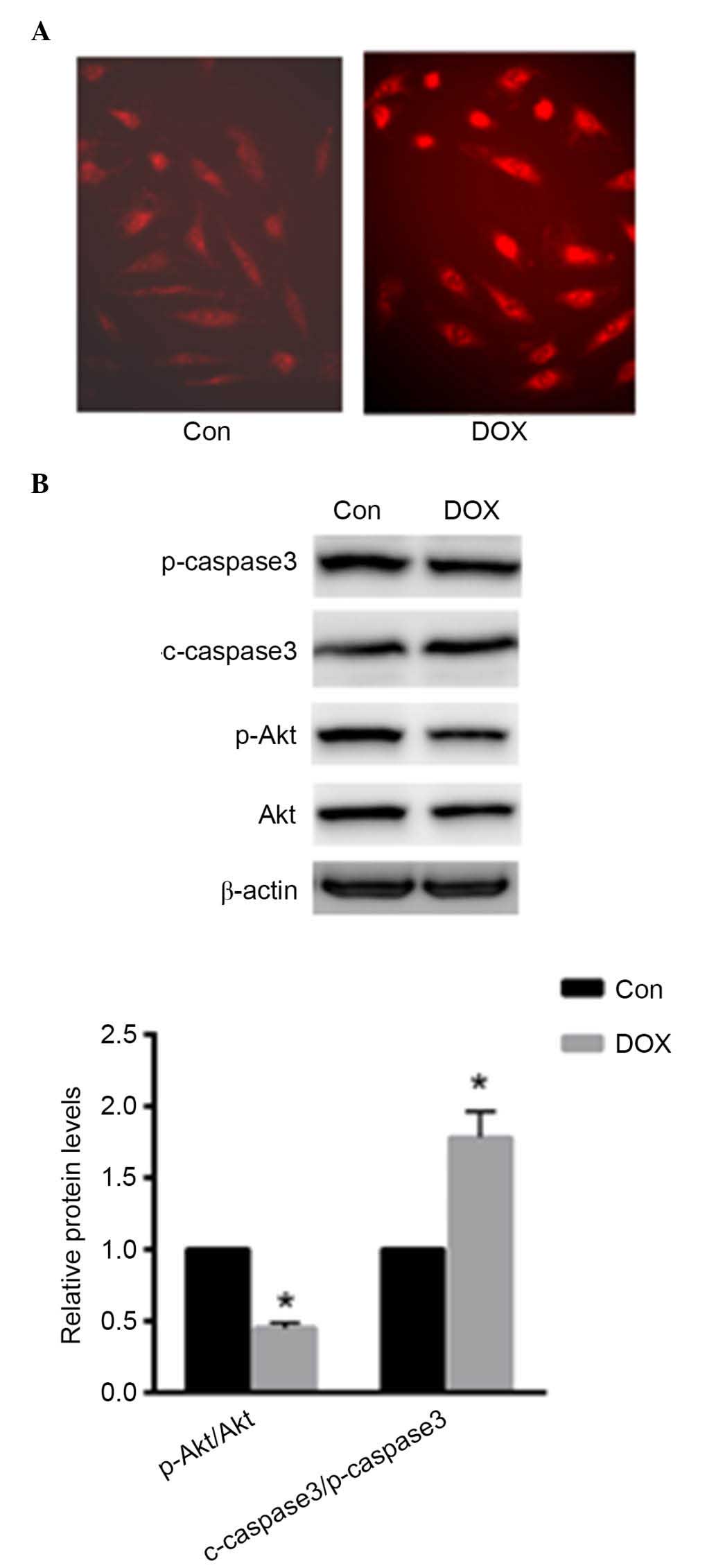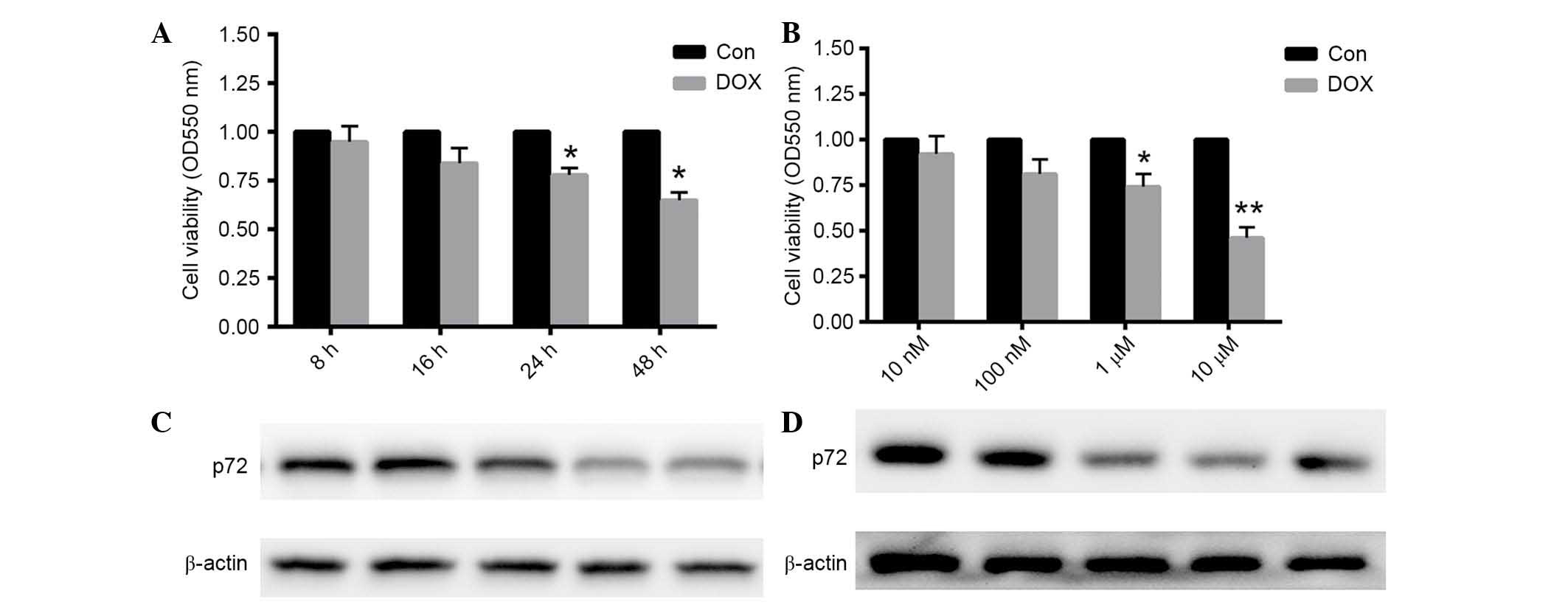The protective role of p72 in doxorubicin‑induced cardiomyocytes injury in vitro
- Authors:
- Published online on: August 8, 2016 https://doi.org/10.3892/mmr.2016.5600
- Pages: 3376-3380
Abstract
Introduction
Doxorubicin (DOX) is widely used to treat malignancies (1), however, it has been challenged due to its cardiotoxicity (2). Chronic toxicity is closely associated with typical features of heart failure and electrocardiographic abnormalities (3,4). Previous studies have indicated that cardiomyocyte apoptosis and intracellular calcium dysregulation may be key in DOX-induced heart injury (5,6).
RNA helicases are responsible for ribonucleoprotein remodeling (7). DEAD-box (DDX) proteins are considered the largest family (8). p72 is transcribed from probable ATP-dependent RNA helicase DDX17 mRNA and it is suggested to be key in cancer progression (9). In breast tumors, p72 was demonstrated to be widely overexpressed and functions in estrogen receptor α (ERα) activation, thus, enhancing its oncogenic activities (10). In colorectal tumors and adenocarcinomas, p72 has also been indicated to be abnormally upregulated by increasing β-catenin (11,12). However, less research has been conducted into the role of p72 on cardiomyocyte injury.
ER activation is reported to reduce cardiac infarct size and ventricular arrhythmias, predominantly via activation of the downstream PI3K/Akt signaling pathway (13). The present study investigated the role of p72 in DOX-induced cardiomyocyte injury in neonatal rat cardiomyocytes, which may elucidate possible underlying mechanisms in reducing DOX-induced cardiomyocyte apoptosis.
Materials and methods
Isolation and culture of rat cardiomyocytes
Neonatal rat cardiomyocytes were isolated from 1-day-old Sprague Dawley rats (Sibeifu Co., Beijing, China), the heart tissue was digested with trypsin and type II collagenase. The cells were seeded in high glucose Dulbecco's modified Eagle's medium (DMEM; Hyclone; GE Healthcare Life Sciences, Logan, UT, USA) with 10% FBS (Hyclone; GE Healthcare Life Sciences) at the density of 5×104 cells/cm2. The present study was approved by the ethics committee of Henan Provincial People's Hospital (Zhengzhou, China).
Cell culture
HEK293T cells were purchased from American Type Culture Collection (Manassas, VA, USA) and were cultured in DMEM/F12 (Hyclone; GE Healthcare Life Sciences, Logan, UT, USA) supplemented with 10% fetal bovine serum, 100 U/ml penicillin and streptomycin (Invitrogen; Thermo Fisher Scientific, Inc., Waltham, MA, USA) in a 25 cm2 culture flask at 37°C in a humidified atmosphere of 5% CO2.
Determination of reactive oxygen species (ROS)
Cells were cultured on six-well chamber slides and washed with phosphate-buffered saline (PBS) three times for 5 min). The slides were incubated with ROS Fluorescent Probe-DHE (Vigorous Biotechnology Beijing Co., Ltd, Beijing, China) in serum-free DMEM/F-12 medium for 30 min at 37°C in a dark environment. The slides were fixed in 4% paraformaldehyde for 20 min at room temperature, washed with PBS for three times and mounted. Immunofluorescence images were captured using a fluorescence microscope.
Dimethyl thiazolyl diphenyl tetrazolium (MTT) assay
Cell viability was determined using a colormetric MTT assay (Sigma-Aldrich, St. Louis, MO, USA). To investigate the effects of DOX on cardiomyocyte viability, cells were cultured at ~70% confluency and cultured in serum-free DMEM overnight. Subsequently, 1, 10, 100 nM, 1, and 10 µM DOX was incubated with the primary cardiomyocytes for 24 h at 37°C. MTT (0.5 mg/ml) was added in fresh medium for 4 h and dimethyl sulfoxide was added into the wells. The absorbance was detected spectrophotometrically at a wavelength of 550 nm. To determine the time-dependent effects of DOX, cells were treated with 1 µM DOX for 8, 16, 24 and 48 h prior to investigation of cell viability according to the above methods. Each experiment was independently performed at least 3 times.
Western blot analysis
Proteins were isolated from cardiomyocytes in radioimmunoprecipitation assay buffer [1% Triton X-100, 150 mmol/l NaCl, 5 mmol/l EDTA and 10 mmol/l Tris-HCl (pH 7.0)] obtained from Beijing Solarbio Science & Technology Co., Ltd. (Beijing, China) with supplementation of protease inhibitor cocktail (Sigma-Aldrich). Protein was quantified using a Pierce BCA Protein assay kit (Thermo Fisher Scientific, Inc.). Cell lysates (10 µg protein) were separated by 10% SDS-PAGE and transferred to a polyvinyl difluoride membrane. The membrane was blocked with 8% milk for 2 h at room temperature. The membrane was incubated at 4°C overnight with primary antibodies as follows (all from Cell Signaling Technology, Inc., Danvers, MA, USA unless otherwise stated): p72 (1:1,000; Abcam, Cambridge, MA, USA; cat. no. ab24601), rabbit anti-ERα (1:1,000; cat. no. 8644), rabbit anti-p-Akt (1:1,000; cat. no. 4060), rabbit anti-Akt (1:1,000; cat. no. 4691), rabbit anti-p-caspase 3 (1:1000; cat. no. 9664), rabbit anti-caspase 3 (1:1000; cat. no. 9665) and mouse anti-β-actin (1:4,000; cat. no. 3700). Following incubation overnight and washing three times for 5 min with PBS with Tween 20, the horseradish peroxidase-conjugated goat anti-rabbit IgG secondary antibodies (1:5,000; Origene Technologies, Beijing, China; cat. no. ZB-2301) were used at room temperature for 2 h. Immunodetection was achieved using the Chemilucent Plus ECL Detection kit (EMD Millipore, Billerica, MA, USA) according to the manufacturer's protocols. Images of the blots were captured using an imager. β-actin served as the internal control and Image J 5.0 (imagej.nih.gov) was used to quantify the results.
TUNEL staining
The TUNEL assay was performed using the In Situ Cell Death Detection kit (Roche Diagnostics, Basel, Switzerland). Following staining, the cells were washed with cold PBS and examined under a fluorescence microscope.
Overexpression of p72
Phusion High-Fidelity enzyme (Thermo Fisher Scientific, Inc.) was used for cloning purposes. The entire p72 cDNA was amplified by RT-PCR using specific primers for p72-BamHI-forward (GCGGATCCCCGCGGCACTGCCCGGTTTG) and p72-EcoRI-reverse (GCGAATTCTACAAGTCTTTCAAGTCTTA) and then cloned into the expression vector, pCDH-CMV-MSC-EF1-copGFP (System Biosciences, Palo Alto, CA, USA) with a Cold Fusion Cloning kit (System Biosciences). Recombinant adenovirus was generated from 293T cells with calcium phosphate precipitation. Primary cardiomyocytes were seeded at 1×106 cells/well in the 6-well plates. Then, the adenovirus vectors were transfected into cardiomyocytes for 48 h.
Statistical analysis
Data were presented as the mean ± standard error of the mean from three independent experiments. Statistical analysis was conducted using Student's t-test on GraphPad Prism 6 (GraphPad, Inc., La Jolla, CA, USA). P<0.05 was considered to indicate a statistically significant difference.
Results
DOX induced ROS production in primary rat cardiomyocytes
Primary cardiomyocytes were treated with 1 µM DOX for 24 h. As presented in Fig. 1A, ROS production was enhanced in primary cardiomyocytes as demonstrated using DHE staining. Furthermore, the present study investigated the protein expression levels of p-caspase-3, c-caspase-3, p-Akt and Akt. Caspase-3 activation was enhanced with DOX treatment, while the phosphorylation level of Akt was reduced (P<0.05; Fig. 1B). These data indicated that DOX induced cardiomyocyte injury by increasing ROS production and apoptosis.
DOX treatment reduced cardiomyocyte viability and decreased p72 expression
Following 1 µM DOX treatment for 8, 16, 24 and 48 h, cell viability was decreased by 22 and 35% at 24 and 48 h, respectively (each P<0.05; Fig. 2A). Preincubation with 10, 100 nM, 1 and 10 µM DOX for 24 h decreased cell viability by 26 and 54% at 1 and 10 µM DOX, respectively (P<0.05 and P<0.01, respectively; Fig. 2B). These results suggested that DOX reduced cardiomyocyte viability in a time- and dose-dependent manner. Furthermore, protein expression levels of p72 were also detected under the same conditions. As presented in Fig. 2C and D, p72 expression levels were decreased following DOX treatment at the concentration of 1 µM for 24 h. Thus, 1 µM DOX was used for 24 h in the remaining experiments.
p72 exerts a protective effect on DOX-induced cardiomyocyte injury
To investigate the effect of p72 on cardiomyocyte apoptosis, adenovirus vectors expressing p72 were introduced into primary cardiomyocytes. As presented in Fig. 3A, overexpression of p72 reduced DOX-induced ROS production in cardiomyocytes. Following induction of p72 overexpression, cell viability was significantly enhanced in the DOX-induced group (P<0.05; Fig. 3B). TUNEL staining was also conducted to detect apoptotic cells. Notably, p72 overexpression significantly reduced DOX-induced cell apoptosis (Fig. 3C). These data indicated that p72 exerts a protective effect in DOX-induced cardiomyocyte injury.
p72 enhances ERα activation and Akt phosphorylation
To investigate the underlying mechanism by which p72 regulates cardiomyocyte viability, the downstream signaling pathway was assessed. As presented in Fig. 4, overexpression of p72 significantly enhanced ERα activation and increased the phosphorylation level of Akt (each P<0.01). By contrast, DOX significantly reduced ERα activation (P<0.05) and increased the phosphorylation level of Akt (P<0.05). These data indicated that p72 overexpression protected against cardiomyocyte injury predominantly by enhancing ERα activation and Akt phosphorylation.
Discussion
In numerous types of malignancy, DOX is commonly applied as an effective antitumor agent. However, it is also found to result in irreversible chronic cardiomyopathy and heart failure (14). A previous study has indicated that oxidative stress may be key in DOX-induced cardiomyocytes (14). In the present study, ROS production and cell apoptosis were demonstrated to be significantly enhanced in cardiomyocytes. Furthermore, DOX reduced cardiomyocyte viability in a time- and dose-dependent manner. These data indicated that DOX induced cardiomyocyte apoptosis predominantly via increased ROS production and activation of caspase-3.
Enhanced ROS production results in aberrant downstream signaling pathways in different cell types (15,16). Thus, the present study investigated the downstream signaling and observed decreased phosphorylation levels of Akt, which has been suggested to enhance cell survival (15). This is consistent with other previous studies, which demonstrate DOX effects PI3K/Akt signaling (15,16).
Estrogen receptors are suggested to be important in various pathophysiologies, including cardiac dysfunctions (17,18). In clinic practice, estrogen treatment markedly improves myocardiac infarct size and heart failure (19). Previous studies have determined that ERs activate the downstream PI3K/Akt signaling pathway, thereby limiting the inflammatory responses in vivo and in vitro (19,20).
As an RNA helicase, p72 binds to double and single stranded RNA. By stimulating ATPase activity, it provides enough energy to unwind RNA duplexes (21). Previous studies have indicated that p72 functions as a transcription activator in an estrogen-dependent manner (21,22). Similarly to p68, p72 directly binds to ERα, thereby stimulating its transcription (23).
The present study demonstrated p72 was reduced following treatment with DOX, suggesting it exerts a possible protective effect. Furthermore, the current study indicated that overexpression of p72 resulted in reduced DOX-induced cardiomyocyte injury. Notably, p72 enhanced ERα activation and downstream Akt phosphorylation. This is consistent with the present study.
In conclusion, the present study demonstrated a protective role of p72 in DOX-induced cardiomyocyte apoptosis, predominantly via ERα activation and PI3K/Akt phosphorylation.
References
|
Smith LA, Cornelius VR, Plummer CJ, Levitt G, Verrill M, Canney P and Jones A: Cardiotoxicity of anthracycline agents for the treatment of cancer: Systematic review and meta-analysis of randomised controlled trials. BMC Cancer. 10:3372010. View Article : Google Scholar : PubMed/NCBI | |
|
Lefrak EA, Pitha J, Rosenheim S and Gottlieb JA: A clinicopathologic analysis of adriamycin cardiotoxicity. Cancer. 32:302–314. 1973. View Article : Google Scholar : PubMed/NCBI | |
|
Wojtacki J, Lewicka-Nowak E and Leśniewski-Kmak K: Anthracycline-induced cardiotoxicity: Clinical course, risk factors, pathogenesis, detection and prevention-review of the literature. Med Sci Monit. 6:411–420. 2000. | |
|
Von Hoff DD, Layard MW, Basa P, Davis HL Jr, Von Hoff AL, Rozencweig M and Muggia FM: Risk factors for doxorubicin-induced congestive heart failure. Ann Intern Med. 91:710–717. 1979. View Article : Google Scholar : PubMed/NCBI | |
|
Zhang S, Liu X, Bawa-Khalfe T, Lu LS, Lyu YL, Liu LF and Yeh ET: Identification of the molecular basis of doxorubicin-induced cardiotoxicity. Nat Med. 18:1639–1642. 2012. View Article : Google Scholar : PubMed/NCBI | |
|
Zhou S, Starkov A, Froberg MK, Leino RL and Wallace KB: Cumulative and irreversible cardiac mitochondrial dysfunction induced by doxorubicin. Cancer Res. 61:771–777. 2001.PubMed/NCBI | |
|
Bleichert F and Baserga SJ: The long unwinding road of RNA helicases. Mol Cell. 27:339–352. 2007. View Article : Google Scholar : PubMed/NCBI | |
|
Jankowsky E, Gross CH, Shuman S and Pyle AM: Active disruption of an RNA-protein interaction by a DExH/D RNA helicase. Science. 291:121–125. 2001. View Article : Google Scholar : PubMed/NCBI | |
|
Uhlmann-Schiffler H, Rössler OG and Stahl H: The mRNA of DEAD box protein p72 is alternatively translated into an 82-kDa RNA helicase. J Biol Chem. 277:1066–1075. 2002. View Article : Google Scholar | |
|
Yager JD and Davidson NE: Estrogen carcinogenesis in breast cancer. N Engl J Med. 354:270–282. 2006. View Article : Google Scholar : PubMed/NCBI | |
|
Causevic M, Hislop RG, Kernohan NM, Carey FA, Kay RA, Steele RJ and Fuller-Pace FV: Overexpression and poly-ubiquitylation of the DEAD-box RNA helicase p68 in colorectal tumours. Oncogene. 20:7734–7743. 2001. View Article : Google Scholar : PubMed/NCBI | |
|
Yang L, Lin C, Zhao S, Wang H and Liu ZR: Phosphorylation of p68 RNA helicase plays a role in platelet-derived growth factor-induced cell proliferation by up-regulating cyclin D1 and c-Myc expression. J Biol Chem. 282:16811–16819. 2007. View Article : Google Scholar : PubMed/NCBI | |
|
Wu CH, Liu JY, Wu JP, Hsieh YH, Liu CJ, Hwang JM, Lee SD, Chen LM, Chang MH, Kuo WW, et al: 17beta-estradiol reduces cardiac hypertrophy mediated through the up-regulation of PI3K/Akt and the suppression of calcineurin/NF-AT3 signaling pathways in rats. Life Sci. 78:347–356. 2005. View Article : Google Scholar : PubMed/NCBI | |
|
Ivanov D, Shabalov N, Petrenko Y, Shabalova N and Treskina NA: The specific characteristics of DIC syndrome vary with different clinical settings in the newborn. J Matern Fetal Neonatal Med. 27:1088–1092. 2014. View Article : Google Scholar | |
|
Xu J, Qian J, Xie X, Lin L, Zou Y, Fu M, Huang Z, Zhang G, Su Y and Ge J: High density lipoprotein protects mesenchymal stem cells from oxidative stress-induced apoptosis via activation of the PI3K/Akt pathway and suppression of reactive oxygen species. Int J Mol Sci. 13:17104–17120. 2012. View Article : Google Scholar | |
|
Muzi-Filho H, Bezerra CG, Souza AM, Boldrini LC, Takiya CM, Oliveira FL, Nesi RT, Valença SS, Einicker-Lamas M, Vieyra A, et al: Undernutrition affects cell survival, oxidative stress, Ca2+ handling and signaling pathways in vas deferens, crippling reproductive capacity. PLoS One. 8:e696822013. View Article : Google Scholar : PubMed/NCBI | |
|
Zhong L, Zhou XL, Liu YS, Wang YM, Ma F, Guo BL, Yan ZQ and Zhang QY: Estrogen receptor α mediates the effects of notoginsenoside R1 on endotoxin-induced inflammatory and apoptotic responses in H9c2 cardiomyocytes. Mol Med Rep. 12:119–126. 2015.PubMed/NCBI | |
|
Wang T, McDonald C, Petrenko NB, Leblanc M, Wang T, Giguere V, Evans RM, Patel VV and Pei L: Estrogen-related receptor α (ERRα) and ERRγ are essential coordinators of cardiac metabolism and function. Mol Cell Biol. 35:1281–1298. 2015. View Article : Google Scholar : PubMed/NCBI | |
|
Mahmoodzadeh S, Leber J, Zhang X, Jaisser F, Messaoudi S, Morano I, Furth PA, Dworatzek E and Regitz-Zagrosek V: Cardiomyocyte-specific estrogen receptor alpha increases angiogenesis, lymphangiogenesis and reduces fibrosis in the female mouse heart post-myocardial infarction. J Cell Sci Ther. 5:1532014. View Article : Google Scholar : PubMed/NCBI | |
|
Wu KL, Chen CH and Shih CD: Nontranscriptional activation of PI3K/Akt signaling mediates hypotensive effect following activation ofestrogen receptor β in the rostral ventrolateral medulla of rats. J Biomed Sci. 19:762012. View Article : Google Scholar | |
|
Huang Y and Liu ZR: The ATPase, RNA unwinding, and RNA binding activities of recombinant p68 RNA helicase. J Biol Chem. 277:12810–12815. 2002. View Article : Google Scholar : PubMed/NCBI | |
|
Watanabe M, Yanagisawa J, Kitagawa H, Takeyama K, Ogawa S, Arao Y, Suzawa M, Kobayashi Y, Yano T, Yoshikawa H, et al: A subfamily of RNA-binding DEAD-box proteins acts as an estrogen receptor alpha coactivator through the N-terminal activation domain (AF-1) with an RNA coactivator, SRA. EMBO J. 20:1341–1352. 2001. View Article : Google Scholar : PubMed/NCBI | |
|
Metivier R, Penot G, Hübner MR, Reid G, Brand H, Kos M and Gannon F: Estrogen receptor-alpha directs ordered, cyclical and combinatorial recruitment of cofactors on a natural target promoter. Cell. 115:751–763. 2003. View Article : Google Scholar |













